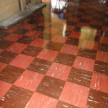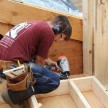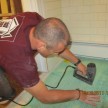How To Remove A Tile Floor and Underlayment
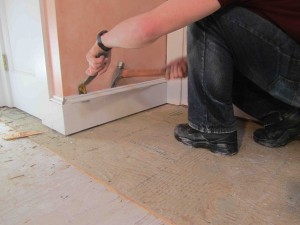 How To Remove Tile and Underlayment Plywood
How To Remove Tile and Underlayment Plywood
This article will focus on how to remove a tile floor and underlayment.
Part of our remodeling project requires us to remove the tile floor and underlayment beneath it. The tile floor needs to be removed so we can rework the plumbing drains for our new American Standard tub and shower fixtures.
Removing tile isn’t an easy project and it can be difficult to do if the tile was set in concrete, commonly referred to as a “old mortar bed” method.. A mud bed job typically means that the tile is attached to 2 to 3 inches of concrete.
Most tile is installed on underlayment which is a layer of material between the sub-floor and the finished floor. Years ago the most common material used by builders was 1/8-inch thick Luan plywood. Today, cement board and fiber cement board are the most common materials used. Underlayment is used to provide a smooth, flat surface that is easily bonded to by tile mortar without damaging the sub-floor, to raise the surface of the floor, or to reinforce the sub-floor and framing system.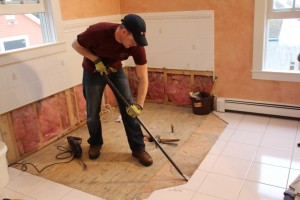
The underlayment is key to the longevity of a ceramic tile floor. The sub-floor by itself does not provide proper support for ceramic tile, not is it a proper material to bond to. [note – only Fir plywood, with no voids, is recommended as a appropriate sub-floor for directly applying tile to.]
Before taking on this project make sure to protect your eyes and hands. Broken shards of ceramic tile is as sharp as glass.
Remove The Trim:
You will also need to remove all of the items sitting on top of the tile. such as baseboard and door casing trim, toilet, tub and vanity is applicable.
After removing the toilet I recommend using a rubber plug or stuff a rag in the hole to keep out the methane gas small. When we are removing tubs, showers or sinks we make sure to shut off the water, drain the pipes and then cut and cap them with Sharkbite connectors.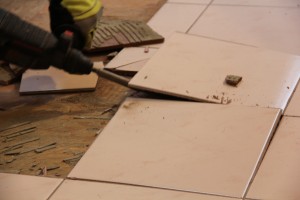
this is also the time to cover any HVAC vents with a breathable filter to allow airflow but stop debris or if you do not need to have the vent working to completely cover it with tape and plastic. This prevents dust from entering the ventilation system.
Removing The Tile:
For about $30, you can buy a floor scraper, a broom-size tool with an angled steel head used to strip off layers of flooring material. Often, the tool is useful for dislodging the flooring material from the adhesive.
Choose a tile in the center of the room and break up by hitting it in the center with a hammer. The point here is to create a foot hold to get a pry bar of special tile scraper between the surrounding tiles and underlayment.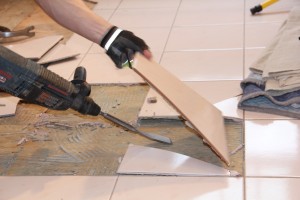
Using your scraper continue to break up tiles. On some floors, this one included, I’ve had excellent results by using a hammer drill with a chisel attachment. I use the chisel to break up and get under tiles and then pry them up to grab.
Some floors come up easy and others hard. An old mortar bed floor sometimes needs to be broken up into pieces with a sledgehammer and then pried up.
I like to use a snow shovel to scoop up the broken tiles and discard them. If your lucky enough to get a dumpster under the window of the room your working at then a simple plywood sled is all you need to get the tiles into the dumpster. If you don’t have that luxury you may need to build a debris chute.
Remove the Underlayment:
After all the tile is removed and you’ve swept up it’s time to focus on removing he underlayment plywood. Remove any visible screws that are accessible. Older floors will have ring shank nails as fasteners and often these nails were applied every six inches.
I find the best practice is to use a large 48 inch long pry bar to lift up and work the edges of the underlayment. sometimes a flat shovel can assist in this process.
Prepare The Sub-floor:
Remove fasteners left in the sub-floor. Use the cat’s paw, claw hammer or pry bar to remove the fasteners before moving on. Screws should be backed out if possible rather than pried loose because they will damage the sub-floor Clean up using a broom and shop vacuum. The wooden subfloor should be completely smooth and solid before installing a new floor.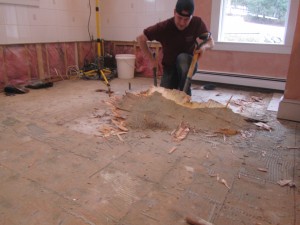
In my case I need to remove some of the sub-floor in order to access plumbing. If you do not have to remove any subfloor then you should re-nail or better yet, screw down the sub-floor to ensure you create a good connection and eliminate squeaks and movement.
Removing the Subfloor If Needed:
Many times the plumber needs a section of subfloor removed. In these circumstances you can sometimes remove just a few boards or cut the plywood subfloor at the nearest joist.
Cutting subfloor boards or plywood is basically the same process. Make sure to use a nail puller to remove all the nails or unscrew and screws. then set your circular saw blade depth to the thickness of the subfloor that you are removing. Make cuts along the center of the joist where you need to cut back to.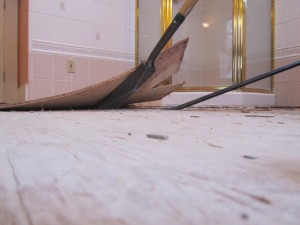
Insert the flat end of the pry bar into a saw cut and begin prying up the subfloor boards or plywood. Later you will replace the missing subfloor with new material, construction adhesive and screws.



